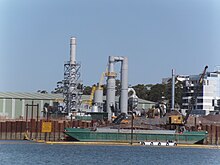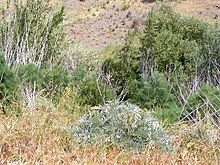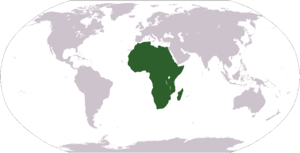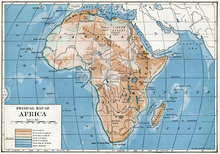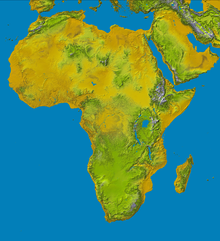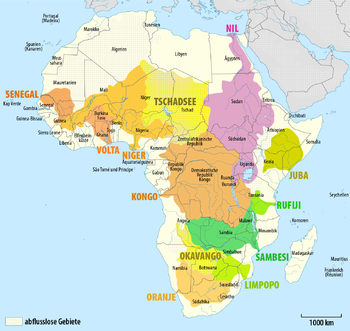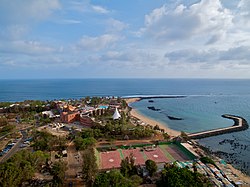A rabbit-proof fence enforces a barrier to protect agriculture areas in Western Australia. Rabbits are an invasive species in Australia.
Environmental issues in Australia describes a number of environmental issues which affect the environment of Australia. There are a range of such issues, some of the relating to conservation in Australia while others, for example the deteriorating state of Murray-Darling Basin, have a direct and serious effect on human land use and the economy.
Many human activities including the use of natural resources have a direct impact on the Australian environment.
These issues are the primary concern of the environmental movement in Australia.
Climate change
Climate change is now a major political talking point in Australia in the last two decades. Persistent drought, and resulting water restrictions
during the first decade of the twenty-first century, are an example of
natural events' tangible effect on economic and political realities .
Australia ranks within the top ten countries globally with respect to greenhouse gas emissions per capital.
The current federal and state governments have all publicly
stated their belief that climate change is being caused by anthropogenic
greenhouse gas emissions. Vocal minority groups within the population
campaign against mining and coal-fired power stations in Australia, and
such demonstrations are widely reported by the mainstream media.
Similarly, vocal minority groups concurrently oppose wind energy
schemes, despite being 'carbon neutral', on the grounds of local visual
and noise impact and concern for the currently high cost and low
reliability of wind energy.
Despite the publication of the Garnaut report and the Green Paper on the proposed Carbon Pollution Reduction Scheme,
public belief in anthropogenic climate change has noticeably eroded
following the leaking of e-mails from the University of East Anglia's
Climate Research Unit.
There is claimed to be a net benefit to Australia in stabilising greenhouse gases in the atmosphere at 450ppm CO2 eq
in line with the prevailing political stance. Public disagreement with
this opinion is generally dismissed as expression of vested interests,
for example from the coal industry.
Energy use
Australia is a major exporter and consumer of coal, the combustion of which liberates CO2. Consequently, in 2003 Australia was the eighth highest emitter of CO2 gases per capita in the world liberating 16.5 tonnes per capital.
Australia is claimed to be one of the countries most at risk from climate change according to the Stern report.
Most of Australia's demand for electricity depends upon coal-fired thermal generation,
owing to the plentiful indigenous coal supply, limited potential
electric generation and political unwillingness to exploit indigenous
uranium resources (although Australia accounted for the world's second
highest production of uranium in 2005 to fuel a 'carbon neutral' domestic nuclear energy program.
Conservation
Conservation
in Australia is an issue of state and federal policy. Australia is one
of the most biologically diverse countries in the world, with a large
portion of species endemic to Australia. Preserving this wealth of biodiversity is important for future generations.
A key conservation issue is the preservation of biodiversity,
especially by protecting the remaining rainforests. The destruction of
habitat by human activities, including land clearing, remains the major
cause of biodiversity loss
in Australia. The importance of the Australian rainforests to the
conservation movement is very high. Australia is the only western
country to have large areas of rainforest intact. Forests provide
timber, drugs, and food and should be managed to maximize the possible
uses. Currently, there are a number of environmental movements and
campaigners advocating for action on saving the environment, one such
campaign is the Big Switch.
Land management issues including clearance of native vegetation,
reafforestation of once-cleared areas, control of exotic weeds and
pests, expansion of dryland salinity, and changed fire regimes.
Intensification of resource use in sectors such as forestry, fisheries,
and agriculture are widely reported to contribute to biodiversity loss
in Australia. Coastal and marine environments also have reduced
biodiversity from reduced water quality caused by pollution and
sediments arising from human settlements and agriculture. In central New
South Wales where there are large plains of grassland, problems have
risen from—unusual to say—lack of land clearing.
The Daintree Rainforest, a tropical rainforest near Daintree, Queensland
covering around 1200 square kilometres, is threatened by logging,
development, mining and the effects of the high tourist numbers.
There are some government programs in Australia which are the
opposite of conservation (such as killing wildlife); an example of this
is shark culling, which currently occurs in New South Wales and Queensland.
Native fauna
The Tasmanian devil, officially listed as an endangered species in 2008.
Over a hundred species of fauna are currently under serious threat of
extinction. The plight of some of these species receives more
attention than others and recently the focus of many conservation
organisations has been the critically endangered northern hairy-nosed wombat, the endangered Tasmanian devil, northern tiger quoll, south eastern red-tailed black cockatoo, southern cassowary, Tasmanian wedge-tailed eagle, Leadbeater's possum and southern corroboree frog.
Marine conservation
Recent climate change reports have highlighted the threat of higher water temperatures to the Great Barrier Reef
One of the notable issues with marine conservation in Australia is the protection of the Great Barrier Reef.
The Great Barrier Reef's environmental pressures include water quality
from runoff, climate change and mass coral bleaching, cyclic outbreaks
of the crown-of-thorns starfish, overfishing, and shipping accidents.
The government of Queensland currently kills sharks in the Great Barrier Reef using drum lines, causing damage to the marine ecosystem.
Whaling
Whaling in Australia took place from colonisation in 1788. In 1979 Australia terminated whaling and committed to whale protection. The main varieties hunted were humpback, blue, right and sperm whales.
Shark culling
Western Australia culled sharks in 2014, killing dozens of tiger sharks and causing public protest.
Later that year it was abandoned, and the government of Western
Australia continued to shoot and kill sharks it believed to be an
"imminent threat" to humans from 2014 to 2017; this policy was criticized by senator Rachel Siewart for being environmentally damaging.
From 1962 to the present, the government of Queensland has killed sharks on drum lines and shark nets, a process that also kills other animals such as dolphins and dugongs. From 1962 to 2018, Queensland's "shark control" program killed roughly 50,000 sharks, including sharks in the Great Barrier Reef. Queensland's shark-killing program has been called "outdated, cruel and ineffective".
New South Wales has a shark net program that kills sharks as well as other marine life.
Between 1950 and 2008, 352 tiger sharks and 577 great white sharks were
killed in the nets in New South Wales — also during this period, a
total of 15,135 marine animals were killed in the nets, including whales
and turtles.
There has been a very large decrease in the number of sharks in eastern
Australia in recent years, and the shark-killing programs in Queensland
and New South Wales are partly responsible for this decrease.
Jessica Morris of Humane Society International calls shark culling
a "knee-jerk reaction" and says, "sharks are top order predators that
play an important role in the functioning of marine ecosystems. We need
them for healthy oceans."
Oil spills
While there have been no oil spill environmental disasters of the scale of the Exxon Valdez in the country, Australia has a large oil industry and there have been several large oil spills. Spills remain a serious threat to the marine environment and Australian coastline. The largest spill to date was the Kirki tanker in 1991 which dropped 17,280 tonnes of oil off the coast of Western Australia.
In March 2009, the 2009 southeast Queensland oil spill occurred, where 200,000 litres were spilled from the MV Pacific Adventurer spilling more than 250 tonnes of oil, 30 tonnes of fuel and other toxic chemicals on Brisbane's suburban beaches. Premier Anna Bligh described the spill as "worst environmental disaster Queensland has ever seen".
Ocean dumping
A serious issue to the Australian marine environment is the dumping of rubbish from ships. There have been a number of cases, particularly involving the navy of Australian and other countries polluting Australian waters including the dumping of chemical warfare agents. Recently documented cases include the aircraft carrier USS Ronald Reagan in 2006 which was found to be dumping rubbish off the shores of Moreton Island. In Victoria, a large number of toxic drums containing 1,2-Dichlorobenzene
xylenol, a substance very toxic to aquatic creatures washed up on
beaches during May 2009 presumably fallen off a passing container ship.
Invasive species
Introduced cane toads threaten native species
Australia's geographical isolation
has resulted in the evolution of many delicate ecological relationships
that are sensitive to foreign invaders and in many instances provided
no natural predators for many of the species subsequently introduced.
Introduced plants that have caused widespread problems are lantana and the prickly pear bush. The introduction and spread of animals such as the cane toad or rabbit can disrupt the existing balances between populations and develop into environmental problems. The introduction of cattle into Australia and to a lesser extent the dingo, are other examples of species that have changed the landscape. In some cases the introduction of new species can lead to plagues and the extinction of endemic species.
The introduced species red fox has single-handedly caused the extinction of several species. Tasmania takes the threat of red fox
introduction so seriously that it has a government sponsored taskforce
to prevent fox populations from taking hold on the island.
Land degradation
According to Jared Diamond, "Australia's number-one environmental problem [is] land degradation". Land degradation results from nine types of damaging environmental impacts:
- Clearance of native vegetation
- Overgrazing by sheep
- Rabbits
- Soil nutrient exhaustion
- Soil erosion
- Man-made droughts
- Weeds
- Misguided governmental policies
- Salinization
Logging and woodchopping
Clearcutting of old growth forests
is continuing in parts of Australia. This often involves the
destruction of natural ecosystems and the replacement with monoculture
plantations.
Land clearing
In the prehistory of Australia the Indigenous Australians used fire-stick farming
which was an early form of land clearing which caused long term changes
to the ecology. With European colonisation land clearing continued on a
larger scale for agriculture - particularly for cattle, cotton and
wheat production. Since European settlement a total of 13% of native
vegetation cover has been lost. The extinction of 20 different mammals, 9
bird and 97 plant species have been partially attributed to land
clearing. Land clearing is a major source of Australia’s greenhouse gas
emissions, and contributed to approximately 12 percent of Australia’s
total emissions in 1998.
The consequences of land clearing include dryland salinity and soil erosion. These are a major concern to the landcare movement in Australia.
The clearing of native vegetation is controlled by Federal laws
(indirectly), State law and local planning instruments. The precise
details of regulation of vegetation clearing differ according to the
location where clearing is proposed.
Soil salinity
Soil salinity affects 50,000 km² of Australia and is predominantly due to land clearance.
Waterway health
A Parks Victoria litter trap on the river catches floating rubbish on the Yarra at Birrarung Marr
The protection of waterways in Australia is a major concern for
various reasons including habitat and biodiversity, but also due to use
of the waterways by humans.
The Murray-Darling Basin is under threat due to irrigation in Australia, causing high levels of salinity which affect agriculture and biodiversity in New South Wales, Victoria and South Australia. These rivers are also affected by pesticide run-off and drought.
Australian waterways facing environmental issues
Rivers and creeks in urban areas also face environmental issues, particularly pollution.
Victoria
- Port Phillip (contamination - silt; sediment; toxins; household chemicals; garden chemicals; E. coli; litter; flotsam and jetsam)
- Yarra River (contamination - E. coli; litter - 13 traps; logging; erosion; salinity)
- Maribyrnong River (contamination - arsenic and heavy metals; litter - 1 trap)
- Mullum Mullum Creek (contamination - E. coli; litter)
- Murray River (salinity, erosion)
New South Wales
Remediation of soil and sediment from Homebush Bay on the Parramatta River by desorbtion and incineration
- Parramatta River (contamination - dioxins, arsenic, coal tars, chromium, lead and phthalates)
- Darling River (salinity, erosion)
- Murray River (salinity, erosion)
- Cooks River (pollution, algal blooms)
Queensland
- Bremer River (water grading F - lowest possible)
- Brisbane River
- Oxley Creek (water grading D)
- Bulimba Creek (threatened species due to land degradation; pollution; litter)
South Australia
- River Torrens (contaminants - E. coli; algal bloom)
Water use
Water use is a major sustainability issue in Australia in regards to
water security. Reliable and safe water sources are threatened by a
number of factors. These include climate change, rainfall variability,
population growth, economic development, and drought.
Australia also has naturally highly variable rainfall influenced
by events such as El Niño and La Niña. An El Niño was declared in May
2015. The El Niño’s likely impact will be drier and warmer conditions
across inland eastern Australia. Importantly, the strength of an El Niño
does not always indicate how severely Australia may be affected.
Dryer conditions and droughts, such as the one south east
Australia is currently experiencing, increase pressure on the water
supply of effected regions. In particular, increased water demands and
reduced stream flows have seen a decline in surface water storage
volumes.
Urbanisation
The urban sprawl of Melbourne.
Australia is one of the most urbanised countries in the world. Many
Australian cities have large urban footprints and are characterised by
an unsustainable low density urban sprawl.
This places demand on infrastructure and services which contributes to
the problems of land clearing, pollution, transport related emissions,
energy consumption, invasive species, automobile dependency and urban heat islands.
A Queensland beach with the skyline of the heavily developed Gold Coast
in the background. Formerly swamplands, the city was urbanised on a
coastal strip between waterways and the sea and now contains many high
rises.
The urban sprawl continues to increase at a rapid rate in most
Australian cities, particularly the state capital cities, all of which
(with the exception of Hobart) are metropoleis. In some centres, such as Sydney and Greater Western Sydney, Greater Melbourne and South East Queensland large metropolitan conurbations threaten to extend for hundreds of kilometres and based on current population growth rates are expected to become megacities in the 21st century. Most Australian cities population growth is a result of migration in contrast to the Birth rate and fertility rate in Australia, which is contributing to the ongoing trend of urbanisation.
In recent years, some cities have implemented transit-oriented development strategies to curb the urban sprawl. Notable examples include Melbourne 2030, South East Queensland Regional Plan and the Sydney Metropolitan Strategy. There are also population decentralisation
programs at state and federal levels aimed at shifting populations out
of the major centres and stemming the drivers to rapid urbanisation. Albury-Wodonga
was part of the federal government's program of decentralisation begun
in the 1970s, which has at times had relocation policies for
immigration. The Victorian government has run a decentralisation
program since the 1960s, having had a ministerial position appointed and
ongoing promotional and investment programs for stimulating growth in
Regional Victoria. However policy has swung over the decades, primarily
due to local development priorities and agendas and a lack of federal
co-ordination to the problem.
Issues include large quantities of e-waste and toxic waste going into landfill. Australia does not have restrictions on the dumping of toxic materials that are common in other countries, such as dumping Cathode Ray Tubes
which leach heavy metals into water catchments. Due to the lack of
sufficient sites for toxic waste disposal large quantities of toxic
waste are trucked between states to remote dumping grounds or exported
overseas in ships.
Mining issues
Australia has the largest reserves of uranium in the world and there has been a number of enquiries on uranium mining. The anti-nuclear movement in Australia is actively opposing mining as well as preventing the construction of nuclear power plants.
At least 150 leaks, spills and licence breaches have occurred at the Ranger uranium mine between 1981 and 2009.





